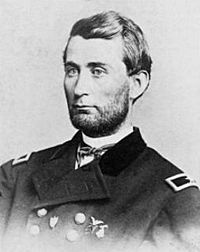Smith D. Atkins facts for kids
Quick facts for kids
Smith Dykins Atkins
|
|
|---|---|

Smith Dykins Atkins
|
|
| Born | June 9, 1836 Horseheads, New York |
| Died | March 27, 1913 (aged 76) Freeport, Illinois |
| Place of burial |
City Cemetery in Freeport
|
| Allegiance | United States of America |
| Service/ |
United States Army Union Army |
| Years of service | 1861–65 |
| Rank | |
| Unit | 11th Illinois Infantry |
| Commands held | 92nd Illinois Mounted Infantry |
| Battles/wars | American Civil War |
| Other work | newspaper editor, postmaster, author |
Smith Dykins Atkins (June 9, 1836 – March 27, 1913) was an American newspaper editor and lawyer. He became a Union Army colonel during the American Civil War. He even led groups of soldiers and cavalry. For his brave service, he received special honorary ranks called brevet grades, becoming a brevet brigadier general and major general of Volunteers. After the war, he went back to editing newspapers and also wrote books.
Contents
Smith Atkins: A Civil War Hero
Early Life and First Steps
Smith Dykins Atkins was born in Horseheads, New York, in 1836. When he was about nine years old, his family moved to Illinois. He later studied at the Rock River Seminary in Mount Morris.
While still young, he became the editor of his town's newspaper, the Gazette. He also started working as a lawyer. Atkins was a big supporter of Abraham Lincoln and helped him get elected as President. In 1860, Atkins was chosen as the Prosecuting Attorney for his area. When the Civil War began, he was the very first person in his county to join the army as a volunteer private soldier.
Fighting for the Union
When President Lincoln asked for volunteers to join the army, Atkins quickly decided to fight for the Union. He served in the western part of the Civil War.
- On April 30, 1861, he became a captain in the 11th Illinois Infantry.
- He was promoted to major on March 21, 1862.
- He briefly worked as an assistant adjutant general but took a break for health reasons.
Atkins returned to the army in the fall of 1862. On September 4, he was made a colonel and put in charge of the 92nd Illinois Mounted Infantry. He led different groups of soldiers, including cavalry (soldiers on horseback).
One of his most important roles was leading a cavalry brigade during Major General William T. Sherman's famous March to the Sea. This was a major event in the war where Union forces marched through Georgia, causing a lot of damage to the Confederacy.
Honorary General Ranks
Even though Atkins wasn't officially promoted to a full general during the war, he earned special recognition.
- On January 23, 1865, President Lincoln nominated him for the honorary rank of brevet brigadier general of volunteers. This rank was confirmed by the U.S. Senate on February 14, 1865.
- Atkins left the army on June 21, 1865.
- Later, on March 21, 1866, President Andrew Johnson nominated him for an even higher honorary rank: brevet major general of volunteers. The Senate confirmed this on April 26, 1866. These "brevet" ranks were given to recognize outstanding service and bravery.
Leading Different Groups
During the Civil War, Smith Dykins Atkins commanded several different groups of soldiers for the Union Army. He led both infantry (foot soldiers) and cavalry (soldiers on horseback) brigades at various times.
- He commanded infantry brigades in the Department of the Cumberland and the Army of the Cumberland's Reserve Corps in 1863.
- He also led cavalry brigades in the Department of the Cumberland and the Military Division of the Mississippi in 1864 and 1865.
Marriage to Ella Swain
As the Civil War was ending, General Atkins was in charge of the Union forces in Chapel Hill, North Carolina. On Easter Sunday, April 17, 1865, he visited the home of David Swain, who was the president of the University of North Carolina. Both men loved history.
While they were talking, President Swain's daughter, Ella, brought them a history book. Atkins soon started spending time with Ella, and they fell in love. They were married on August 23, 1865. Their marriage was a bit controversial because Ella was from the South and Atkins was a Union general. Ella's mother was not happy about it.
The couple lived in Freeport, Illinois. Smith and Ella had six children, but only three lived to become adults. Ella sadly passed away from influenza when she was 38 years old. She is buried in Oakwood Cemetery in Raleigh, North Carolina. Their love story is told in the book Undaunted Heart: The True Story of a Southern Belle & a Yankee General by Suzy Barile. Suzy Barile is a descendant of Ella and Smith Atkins.
Life After the War
After the war, Smith Atkins returned to Freeport. He became the editor of the city's Daily Journal newspaper. He also served as the city's postmaster for 24 years, which means he was in charge of the local post office.
Atkins also wrote at least two books:
- Democracy and Dred Scott in 1860.
- Abraham Lincoln in 1909.
He also wrote an account of his experiences called "With Sherman's Cavalry Marching Through Georgia." He was the first president of the Freeport Public Library and served on the board of education. He was also very active in groups for military veterans. Smith Atkins died in Freeport in 1913 and is buried in the City Cemetery there.

